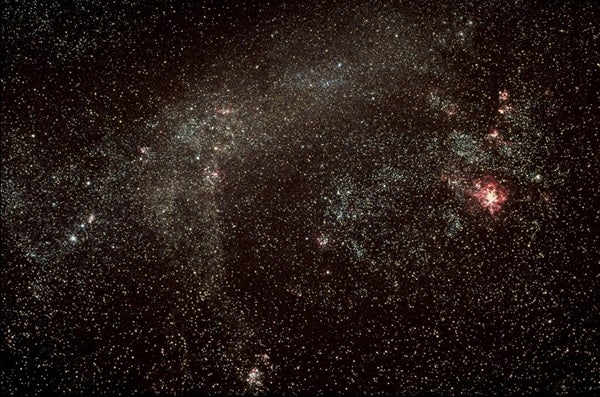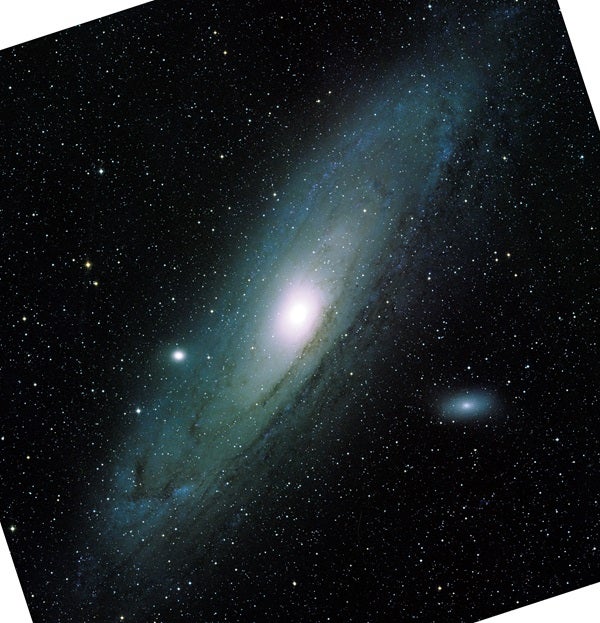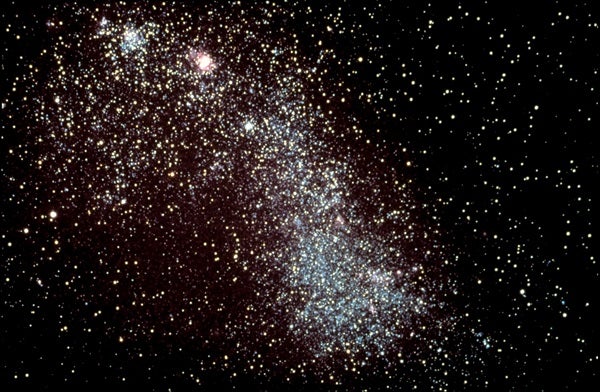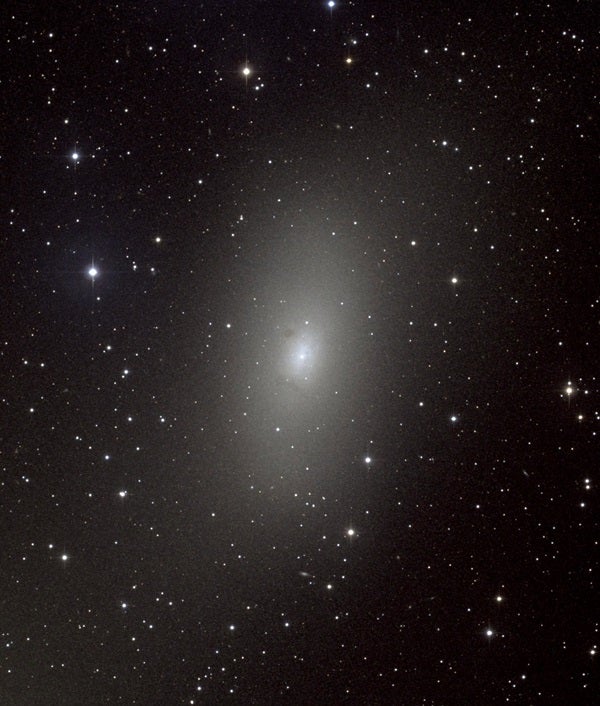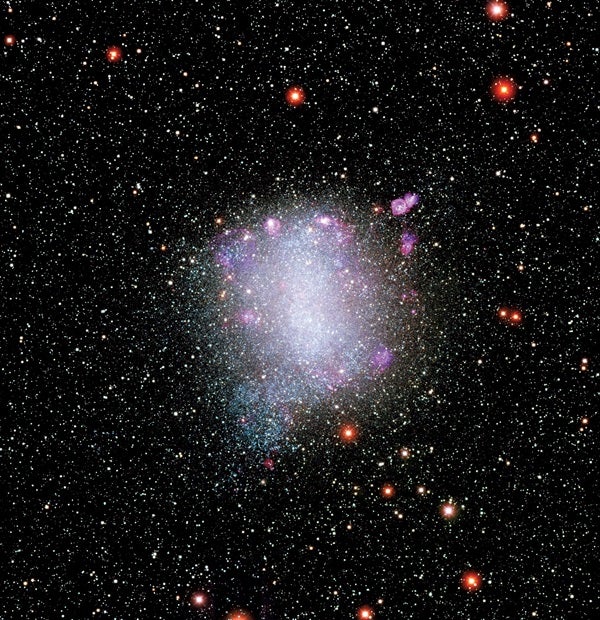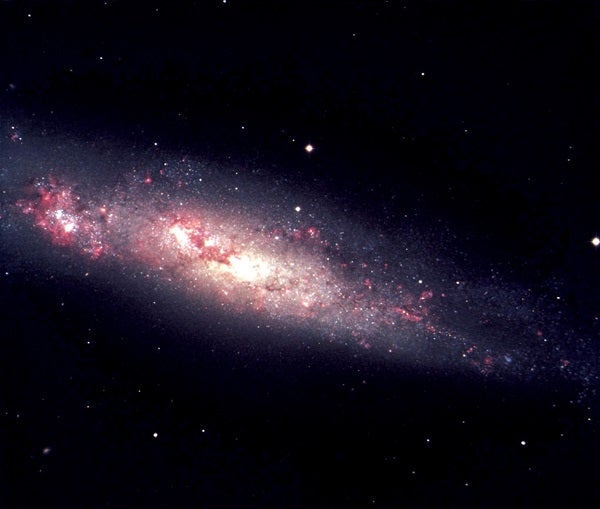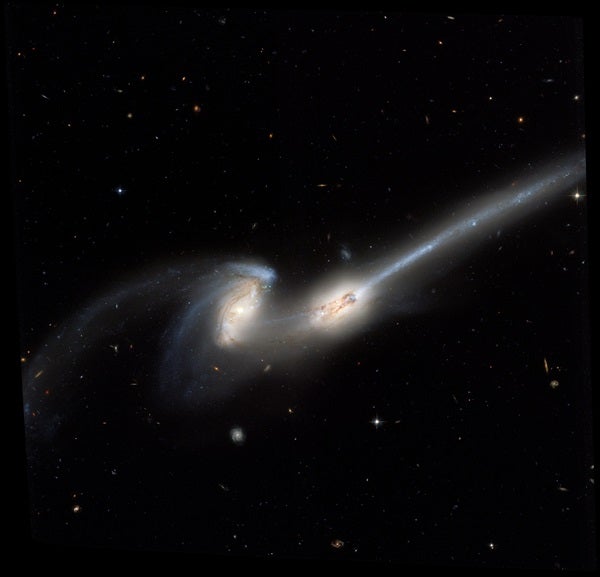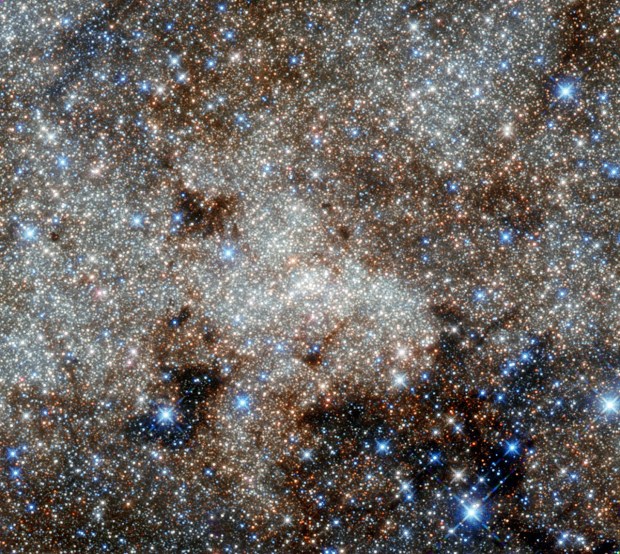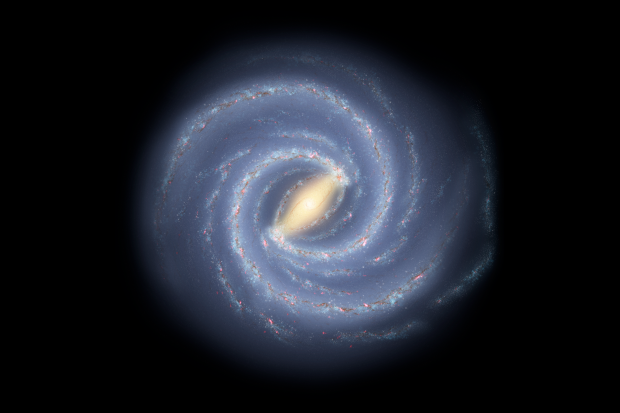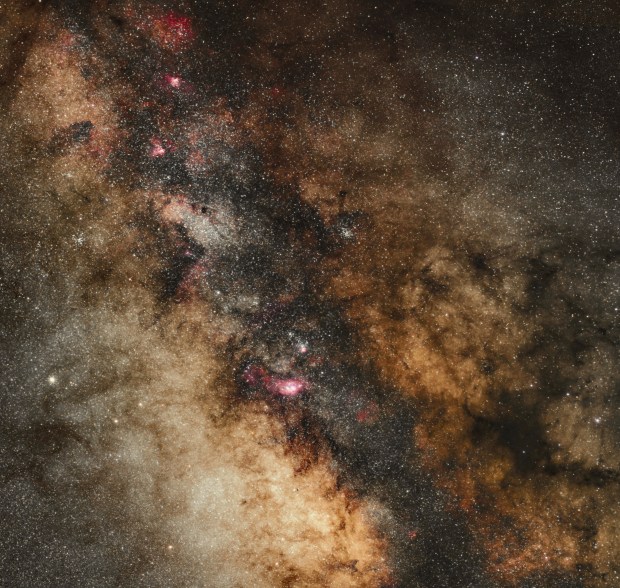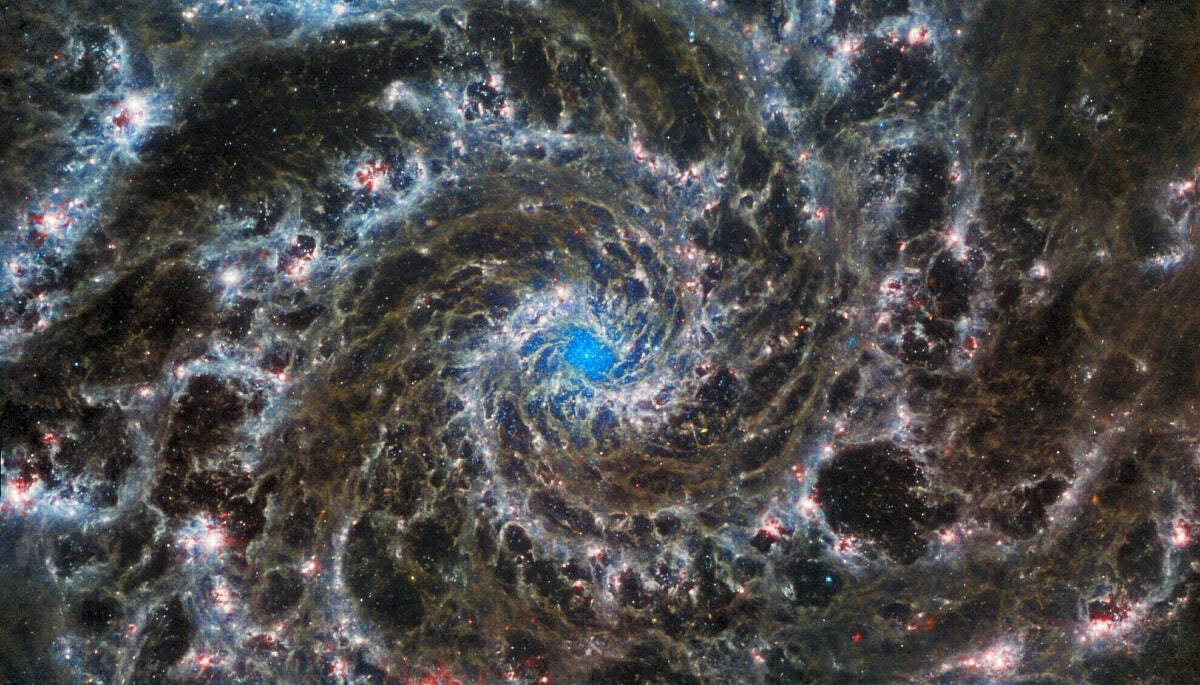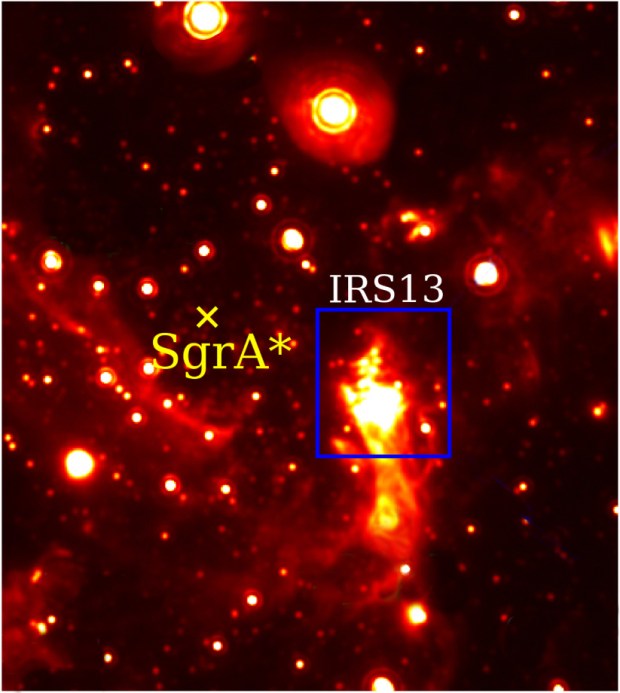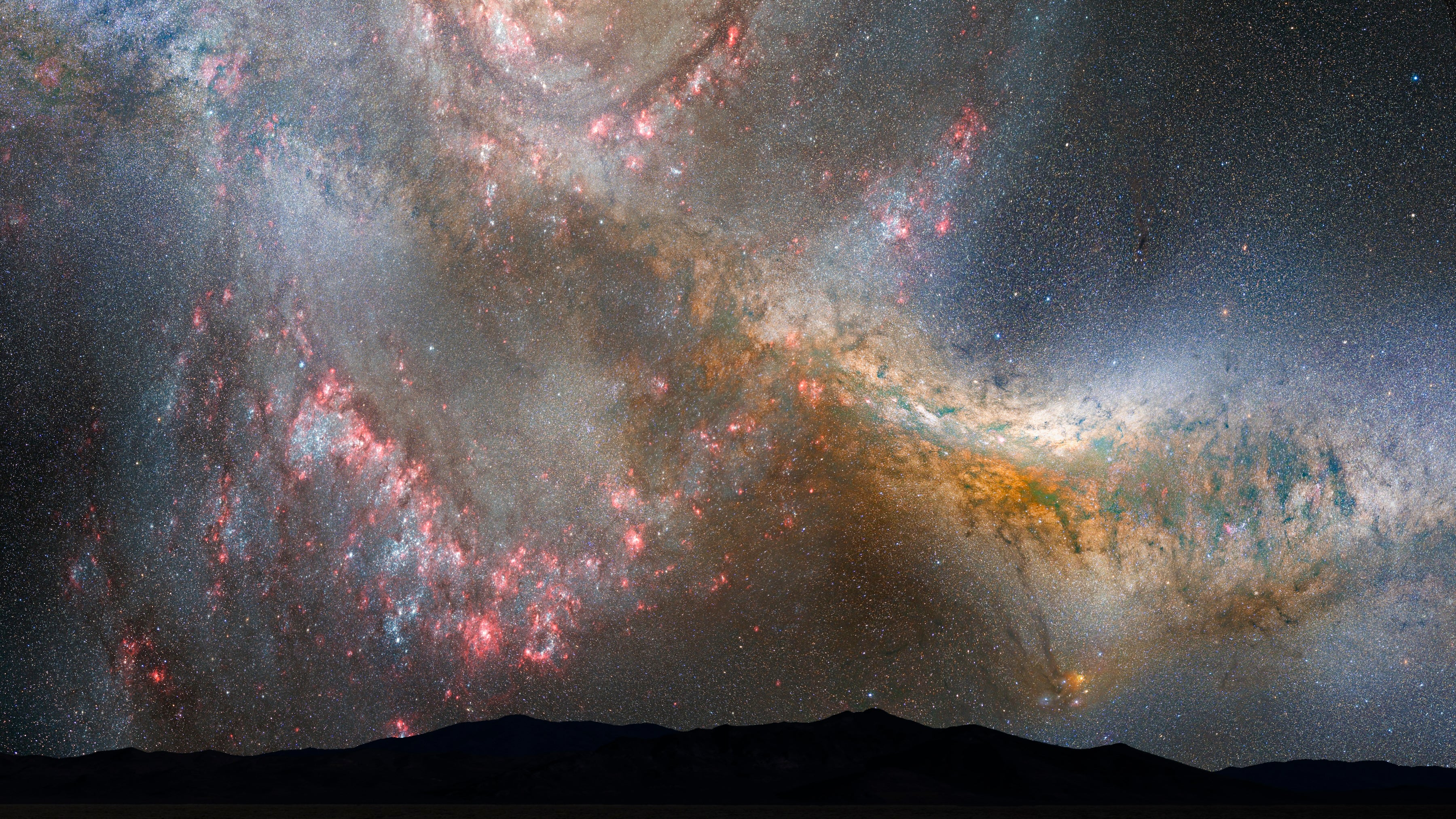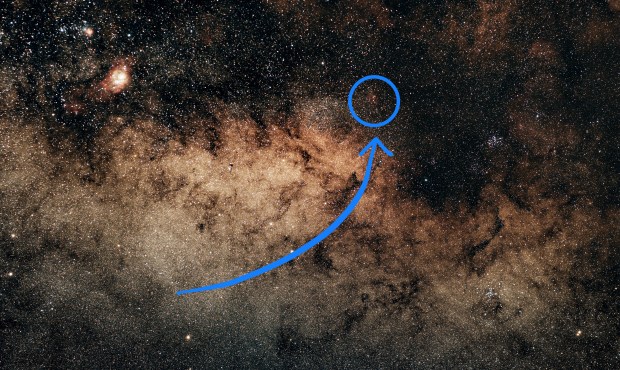Our Local Group of galaxies lies on a side street 50 million light-years from the great intersection of two dark matter filaments that created the magnificent Virgo Cluster of about 2,000 galaxies. To alien astronomers living in the Virgo Cluster, our little galactic neighborhood would appear as two smudges of light: the Milky Way Galaxy and the Andromeda Galaxy (M31). Together, they might be dismissed as a “binary galaxy” on some extraterrestrial’s star chart. Only with extraordinarily powerful telescopes would Virgo astronomers pluck out the roughly four dozen small dwarf galaxies.
The innocuous name Local Group belies the fact that our neighborhood is more like a rough and tumble town in the Wild West. Murder, mayhem, missing bodies — even cannibalism — stalk the streets. In reality, we are seeing order emerge out of the chaos of energy and matter that followed our universe’s birth; the Local Group is a microcosm of the rowdy cosmos at large.
Nearly 10 million light-years across, the Local Group “is the universe in a nutshell,” says Mario Livio, former head of the Space Telescope Science Institute’s science division. But, more importantly, in an expanding and accelerating universe, the Local Group provides our only opportunity to decode the origin, structure, and evolution of galaxies.
New eyes on the Local Group
The road to discovering the Local Group started more than 90 years ago. In 1923, American astronomer Edwin Hubble used the 100-inch Hooker Telescope atop Mount Wilson in Southern California to find Cepheid variable stars in the Andromeda “Nebula.” Scientists had long debated whether this cigar-shaped cloud was an oblique disk around a young star or a vastly more distant “island universe” unto itself. By using the intrinsic brightnesses of Cepheid variables to calculate their distances, Hubble finally had observational evidence to prove the latter. The Andromeda Nebula was extraordinarily far away, at least 20 times the Milky Way’s diameter.
After another decade of meticulous observations, the idea of galaxies being organized into a local grouping “sprang from the mind of Hubble as completely as the goddess Athena, in full battle garb, sprang out of the head of Zeus in Greek mythology,” says retired Canadian astronomer Sidney van den Bergh. Hubble described it as a fortunate accident that the Local Group contains nearly all the types of galaxies he saw in the universe at large.
Hubble likely never envisioned that 90 years later a telescope comparable in size to the Hooker Telescope, lofted far above the blurry atmosphere — and bearing his name — would routinely resolve stars in the Local Group barely 1⁄10,000 the brightness of M31’s Cepheids. “The Hubble Space Telescope has opened up the Local Group to completely new, detailed studies,” says William Harris of McMaster University in Hamilton, Ontario. “What we knew about these systems was in a completely different state [a quarter-
century] ago.”
“With Hubble and large ground-based telescopes, we can get an incredible amount of data on a huge number of individual stars,” says Rosemary Wyse of the Johns Hopkins University in Baltimore. “At last we can try to fit it all together.”
Stars are like clocks in space. The earliest stars — now 13 billion years old — contain few elements heavier than hydrogen and helium. That’s because elements like oxygen, nitrogen, and silicon had not been cooked up yet through nuclear fusion. Younger stars are successively richer in heavier elements forged in earlier generations of stars. So, tracing the abundance of different elements in stars is the astronomer’s equivalent of digging through geologic strata, a way to learn what parts
of the Local Group came first.
From chaos to order
Hubble proposed an evolutionary sequence for elliptical, spiral, and irregular galaxies with his classic Hubble Tuning Fork diagram. But the Hooker Telescope did not have the power to look far enough into the universe to reveal how galaxies might have changed over time.
Today’s Great Observatories Origins Deep Survey, or GOODS program, (using observations by Hubble, the Chandra X-ray Observatory, and the Spitzer Space Telescope) shows increasing galaxy size in the universe is consistent with “bottom-up” models of galaxy formation. In these schemes, galaxies grow through mergers and by accreting smaller galaxies.
Such models support the “cold dark matter” theory, which states dark matter (an invisible form of matter that makes up 85 percent of the universe’s mass) pooled into gravitational “puddles” in the early universe, long before normal matter could. It then collected hydrogen gas that quickly contracted to build star clusters and small galaxies.
These dwarf galaxies merged piece by piece over billions of years to build the immense spiral and elliptical galaxies we see today. The forensic evidence in our Local Group allows astronomers to scrutinize the past 13 billion years in a new level of detail. The results agree beautifully with those from the GOODS program, but some mysteries linger.
Most astronomers think the Local Group “turned on” roughly 13 billion years ago, when seedling star clusters that formed from hydrogen gas flowed into dark matter “potholes.” This occurred at the end of the “Dark Ages,” the brief interval of time when the universe cooled below a temperature of 3,000 degrees Fahrenheit. “We now know a lot of action happened in the first few million years,” says Harris. “Somehow we have to connect all of this into a single formation scenario.”
When the earliest clusters emerged from the Dark Ages, the Local Group was only 600,000 light-years across, just a quarter of the current distance to the Andromeda Galaxy. Higher density means star clusters must have collided and merged quite frequently. Picture these cluster mergers as many little brooks coming together to form streams, which then converge into a mighty river
It’s raining stars
The Milky Way Galaxy today is usually depicted as a sedate-looking disk, bulge, and halo. A DVD makes a useful model. The silvery disk is the approximate diameter-to-thickness ratio of the Milky Way’s stellar disk. The central bulge of stars would be a pingpong ball glued in the DVD’s center. The galactic halo of orphaned stars and surviving globular clusters is a beach-ball-sized swarm enveloping the DVD. Ticker tape streamers arranged in a pretzel pattern through this volume would resemble shreds of dwarf galaxies being devoured by the Milky Way. Now imagine another DVD inside a beach ball located about 10 feet (3 meters) away: That’s the Andromeda Galaxy. Dwarf galaxies would be scattered between these two beach balls out to a distance of about 15 feet (4.6 m).
The emerging view is that early globular star clusters crashed together to build up the Milky Way’s central bulge. The Milky Way pulled in surrounding gas, which settled into a vast, thin disk. Cluster collisions scattered stars into a halo, and the disk puffed up, becoming thicker.
Only a fraction of the original globular clusters survive today. Harris compares them to old castles in different states of disrepair. Their ability to survive depends on their mass and trajectory through their host galaxy — either M31 or the Milky Way. Some of the globular clusters are relatively unscathed; some have been torn into star streams.
Observations of the Milky Way suggest a complex galaxy shaped by dynamical evolution. “Our galaxy is pretty hungry and is accreting all kinds of satellites in different ways,” says Mary Putman of Columbia University. Put even more succinctly, Wyse says, “Our Milky Way has merged, is merging, and will continue to merge.”
Like a toddler with a face full of jam, the Milky Way is a sloppy eater. The halo contains shreds of smaller galaxies being devoured. The disk is warped by passing dwarf galaxies. High-velocity hydrogen clouds far above the galactic plane trace the destruction of these dwarfs, whose debris literally rains down onto the galactic disk.
One of the earliest clues to cannibalism came in 1992 when astronomers discovered a dwarf galaxy merging with the Milky Way. The great star clouds of Sagittarius largely hide this dwarf. “This could be the archetype of larger satellite galaxy mergers that happened in the past,” says Steven Majewski of the University of Virginia. Computer simulations show this galaxy is being stretched like taffy as it falls into the gravitational sinkhole of our galaxy.
The most obvious relic of our violent past is the Magellanic Stream, a trail of cold hydrogen that extends across 100° of sky without any obvious stars. The prominent satellite galaxies, the Large Magellanic Cloud and Small Magellanic Cloud, are at the head of the stream, which makes an arc around the south galactic pole.
Odd couple
Formation models don’t predict two giant galaxies growing next to each other in such an isolated part of the universe. In fact, M31 may have been even closer to the Milky Way at one time.
Hubble would agree that nature was generous in giving us such a close companion to study. Nature also generously tilted M31 nearly edge-on to our line of sight. This allows its halo, bulge, and disk populations to be segregated rather easily for study. “The Andromeda Galaxy gives us a more democratic view of stellar populations,” says Puragra Guhathakurta of the University of California at Santa Cruz. By comparison, foreground dust and star clouds almost totally obscure the Milky Way’s bulge.
We need to look at M31 because our Milky Way “is not typical,” asserts Wyse. “It has not done much major merging for quite a while.” The Andromeda Galaxy gives astronomers a better view of the complex forensics of cannibalism and large galaxy growth.
Like the Milky Way, M31 contains many globular clusters. One in particular, called G1, may be only masquerading as a globular. It might really be the stripped down core of a dwarf spheroidal galaxy shredded by the Andromeda Galaxy. One piece of evidence: G1 may contain a 20,000-solar-mass black hole — something astronomers once expected to find only in galaxies. Equally mysterious is M33, a disk galaxy that has avoided being torn up by M31. “It should not have survived,” says Ken Freeman of the Mount Stromlo Observatory in Australia.
A striking difference is that both young and old stars abound in M31’s halo, whereas the Milky Way’s halo contains predominantly old stars. This suggests the Milky Way formed in isolation while M31 underwent a major merger that threw a bunch of stars and gas into the halo only 7 billion years ago.
Backyard laboratory
The Local Group serves as an astrophysics laboratory for taking a close-up look at fundamental cosmological mysteries. Our neighborhood offers a sample of the range of massive black holes that emerged in the early universe. Our own homegrown black hole in the galactic core, its cousin in M31, and possible smaller relatives in globular clusters M15 and G1 allow astronomers to study black holes in detail.
A landmark census of galactic black holes by astronomers using the Hubble Space Telescope revealed that a black hole’s mass is roughly no more than 0.2 percent of the mass of a galaxy’s bulge. Amazingly, the suspected black holes found in M15 and G1, which are 10,000 times less massive than a galaxy, also obey this trend. It appears that some yet-to-be-discovered underlying process ties a black hole to its host galaxy.
Astronomers even use the Local Group to reduce the list of dark matter candidates. Scientists have searched the halo of our galaxy looking for invisible objects that would bend the light of background stars; this effect is called gravitational lensing. So far, these searches have ruled out Massive Compact Halo Objects — hypothetical small, dark objects — as the last potential hiding place of baryonic dark matter (made of electrons, protons, and neutrons). The dark matter skeleton has been exorcised from the astrophysical closet. This mysterious material cannot be made of the same atoms that stars, planets, and people are forged from. Instead, it is now a phantom for particle physicists to hunt down.
Living in the Local Group
No doubt, countless extraterrestrial civilizations in the Local Group peruse it with a similar archaeological curiosity and fervor. It is a collective search for our cosmic roots. What’s sobering is that planets may have started being made in the Local Group billions of years before our Sun and Earth formed.
Imagine if the Local Group contains even one extraterrestrial civilization billions of years older than ours. However improbable this scenario, such a civilization could have an archive of the evolution of our galactic neighborhood.
We’ll need such an Encyclopaedia Galactica because the Local Group’s history will get ever blurrier to future astronomers. The big makeover should begin in some 2 billion years when the Milky Way and Andromeda galaxies begin merging. A few billion years after that, the merger will be complete.
Computer simulations and telescopic images of other mergers give exquisite details of what’s in store: Stars will scatter into a huge sphere, long tidal tails will form, and the cores will merge. When the central black holes coalesce, the newly forming galaxy will shudder momentarily in the wake of gravitational waves rippling time and space.
In the far future, astronomers will gaze at the sky and see all the way into the core of a new elliptical galaxy. They will have no evidence that there were once two majestic spiral galaxies called the Milky Way and Andromeda by a long-forgotten civilization.
A look at the nearby giant galaxy NGC 5128, better known as Centaurus A, presages the future of the Local Group after the Milky Way and M31 merge. This monster elliptical, no doubt, has grown through major mergers. Its appetite hasn’t abated. It’s currently cannibalizing a wayward disk galaxy, and shreds of others are in its halo. A refueled supermassive black hole at the core spews out a fountain of energy in the form of extragalactic jets.
The Local Group is being pulled toward the Virgo Cluster at the rate of 3 million light-years every billion years. In an accelerating universe, however, we may never get there because the space between the Virgo Cluster and our Local Group will stretch apart at an even-faster rate.
After untold billions of years, we will be the singular island universe, much like what some of Hubble’s contemporaries believed. An inky sea of absolute nothingness will surround a single elliptical galaxy of purely ancient red stars and a burned-out supermassive black hole. It will no longer be the universe in a nutshell. To far-future inhabitants, it will be the entire observable universe. They will never know the effervescent glory of raw creation and renewal we witness now in our Local Group.

